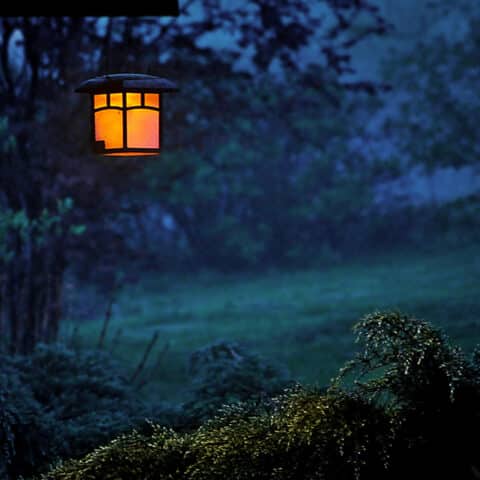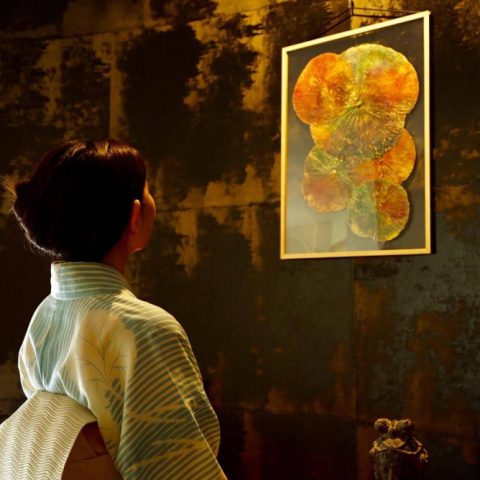
Also known as kadō, Ikebana is by far the most attractive flower arrangement method. Literally, Ikebana means ‘’giving life to flowers.’. Compared to the Western styles of flower arrangement which are commonly marked by placing a bunch of flowers in a vase, Ikebana focuses on aesthetically arranging them in patterns that highlight every piece of the flower: the blossoms, branches, leaves, stems, and buds. It helps calm the soul and establishes an inner relationship between the artist and those attractive flowers. Ikebana is special because it conveys a personalized feeling and message to the viewer.

Ikebana arrangement in earlier periods by Shiro Kasamatsu. Credit: Ukiyo-e-search
Origin of Ikebana
The main origin of Ikebana is still unknown, but it is believed to have started during the 6th century when Chinese Buddhist missionaries brought over their traditions and practices. Other sources state that in pre-Buddhist times, flowers were used to invoke nature gods. Over time, this is how it evolved, forming a mixture of tatebana and Shinto yorishiro to be known as the “Art of Ikebana.” Ikenobo Senkei, a Buddhist priest, is known as the one who created the initial form of Ikebana “tatebana,” which was used in homes to display objects.
Its history prominently started from the Kamakura and Nanboku-cho periods. The murals and other art pieces of these periods have shown flowers being presented from one animal to another being who was interpreted as Buddha. In the Muromachi period, some vessels appeared and ordinary flower arrangements were used as home decoratives. The Heian period is also known for contributing to the tradition of Ikebana since people of that time made flower offerings to Buddhist altars. These arrangements joined and advanced the formation of a new flower arrangement style, kadō.

Unique Ikebana Arrangement. Credit: phongdang
Regions and Artists
Although Ikebana is well-known all over Japan, its practitioners are predominantly found in Tokyo and Kyoto. Some of its well-known practitioners include Junichi Kakizaki, Mokichi Okada, and Yuki Tsuji. The first Ikebana artist to post many of their arrangements online was Toshiro Kawase. He started a project he called “One Day, One Flower” where he posted one arrangement per day online after the 2011 earthquake and tsunami.

Ikebana arrangement by Ohara School of Ikebana Arrangement. Credit: ikebanahq.org
Relationship of Ikebana and Zen
Zen is a Japanese Buddhist way of thinking that aims at civilization and insight through meditation described as “a state of calm attentiveness in which one’s actions are guided by intuition rather than by conscious effort.” This heavily inspires Ikebana since it is also an activity done for the pursuit of inner calmness. Both focus on harmony, balance, minimalism, mindfulness, the transience of life, beauty in routine, a selfless mind, no discrimination, getting rid of negative thoughts, and having a graceful mind, making both Ikebana and Zen meditation two practices that heavily emphasize mental health, well-being, and mindfulness.

Woman with Ikebana Arrangement – Photo Credit: Pixel Shot
Principles of Kadō
Ikebana has four basic principles: fresh approach, movement, balance, and harmony. The three aesthetic elements the practice emphasizes are line, colour, and mass. Arranging the flowers in silence, while paying close attention to detail and focusing on the line and shape being formed are the basics. Asymmetry is very important in arranging flowers and plays a great role in the artistic expression of the arrangement.

Ikebana Tools – Photo Credit: Olena Antonenko
Tools Used
Vases, clippers, watering cans, floral tape, cocktail sticks, cut flower preservatives, secateurs, and a kenzan (a heavy lead plate with erected brass needles used for flower arrangement) are the main tools used in Ikebana. Various types of vases are used but their shapes, colour, and designs are carefully selected to maintain relevance and harmony with the design.
Arrangements and Styles
Ikebana has three basic flower arrangements.

Moribana Style Ikebana – Photo Credit: Olena Antonenko
Moribana:
Moribana typically has a flat container known as kenzan and multiple blooms. Its main feature is a broad area with a mount of pretty, attractive flowers.

Ikebana Ikenobo Shoka style exposition – Photo Credit: Otomodachi on Flickr
Shoka:
Also referred to as Seika, this arrangement mainly features three groupings of plants that roughly form a triangle. It was made popular in the Edo period.

Nageire style arrangement of Ikebana. Credit: PetiteCoco on Flickr
Nageire:
Nageire is the most famous and difficult arrangement of Ikebana. It is a vertical and upright arrangement mostly in a tall, long vase. Although it is closely related to Moribana, Nageire is thought to be older. Due to the focus on verticality in its arrangement, this style doesn’t use kenzan or suiban.
Distinctive Features
The unique attributes of Ikebana include the use of beautiful blooming flowers, mosses, green leaves and stems, buds, and the bright colours of the flowers. The vessels used are mostly in dark colours or white, based on the arrangement, offering a contrast to the flowers they hold. Additionally, the flowers are not forced to stand still but they are allowed to fall naturally, highlighting the temporary nature of beauty.

Ikebana Illustration – Photo Credit: jimdsgn1
Importance
Ikebana is not simply an arrangement of flowers, but a practice that draws attention towards the intricate details of nature we forget. It allows us to appreciate certain things that we normally don’t pay attention to by bringing out the beauty of flowers by focusing on their colour, shape, and bloom. This art of arranging flowers has been practiced for 7 centuries and is still blooming. Today, the Western world is also influenced by it, with Ellen Gordon Allen being the first to bring Ikebana to Western culture, leading to many more modern Ikebana artists to sprout all over the world.

Springtime Ikebana – Photo Credit: Natasha Breen
Ikebana Schools
Many Ikebana schools and learning centres have opened in recent times to teach people the different arrangement styles. These Ikebana institutes include Ikenobo, Sogetsu, and the O’hara school in Japan while Ikebana International New York in the West has gained a lot of notoriety in its own right.

Two examples of the Rikka Style – Photo Credit: Espores
Facts about Ikebana
Ikebana is a thought-provoking and peaceful practice of flower arrangement, and for those who still crave more knowledge about it, we have some amusing and interesting facts to share!
- In earlier periods such as the 19th century, it was thought that the young girls who mastered Ikebana arrangements would have higher chances of meeting a good man and marrying peacefully.
- In the Ashikaga period, the flowers arranged through this technique were always kept high and pointed upward towards heaven to symbolise faith.
- Even the most fearsome samurai are known to have practised Ikebana as a relaxing hobby and in historical periods it was a must for them to be skilled at Ikebana to be recognized as true warriors.
- Ikebana is considered one of the top 3 cultural arts of Japan in addition to the tea ceremony and calligraphy.
- Ikebana is also shown on Japanese TV shows. One such show is Seikei Bijin or Artificial Beauty, a drama TV series that has an ikebana master as a male character and love interest.
If you have a chance make sure to try Ikebana experiences while on your next trip to Japan!
Feature image credit: FusionStudio
Are you planning your trip to Japan and looking for authentic cultural experiences? Book your travel consulting call with our experts to get some great ideas!



